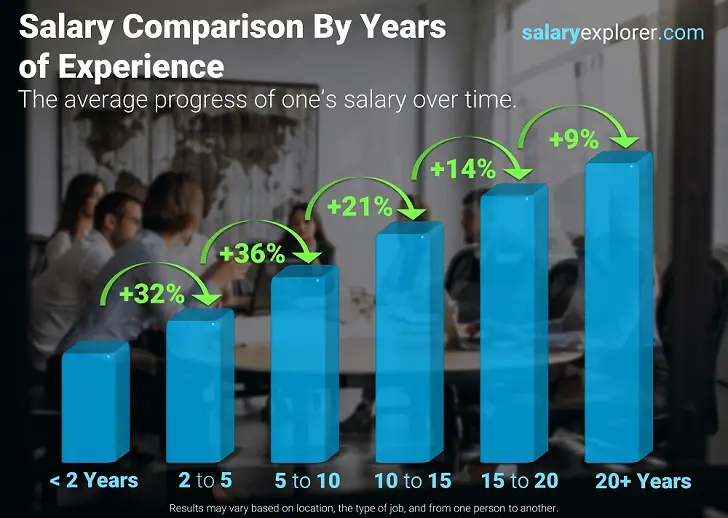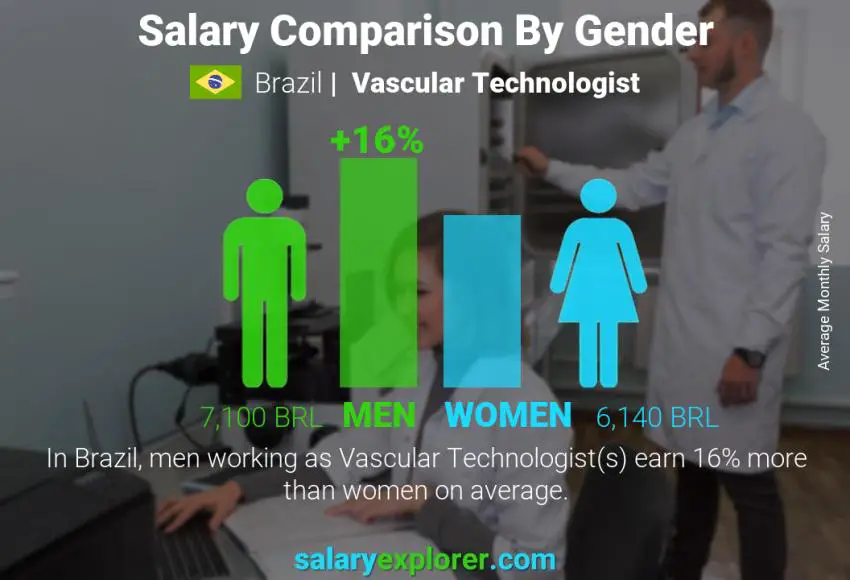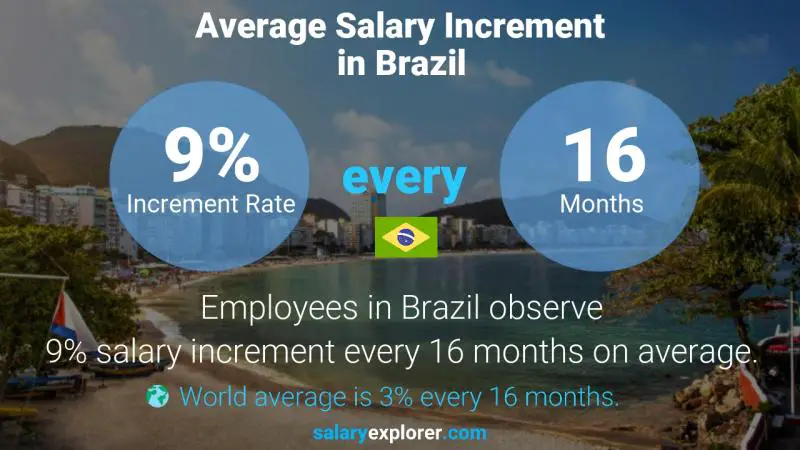Vascular Technologist Average Salary in Brazil 2024
How much money does a person working as Vascular Technologist make in Brazil?

LOW
3,050
BRL AVERAGE
6,620
BRL HIGH
10,500
BRL
A person working as Vascular Technologist in Brazil typically earns around 6,620 BRL. Salaries range from 3,050 BRL (lowest) to 10,500 BRL (highest).
Salary Variance
This is the average salary including housing, transport, and other benefits. Vascular Technologist salaries in Brazil vary drastically based on experience, skills, gender, or location. Below you will find a detailed breakdown based on many different criteria.
Vascular Technologist Pay Scale and Salaries in Brazil

Salary Structure and Pay Scale Comparison
6,280 BRL or more
5,500 to 6,280 BRL
3,790 BRL or less
3,790 to 5,500 BRL
 3,050 BRL |
 6,330 BRL |
 10,500 BRL |
Median Salary, maximum and minimum salary, minimum wage, starting salary, and the salary range
Salary Range, Minimum Wage, and Starting Salary
Salaries for the position Vascular Technologist in Brazil range from 3,050 BRL (starting salary) to 10,500 BRL (maximum salary). It should be noted that the given figure is not the legally mandated minimum wage; rather, it represents the lowest figure reported in a salary survey that included thousands of participants and professionals from all regions of the country.
Median Salary
With a median salary of 6,330 BRL, half of the professionals who work as Vascular Technologist in Brazil earn less than this amount, and the other half earn more. The median salary denotes the middle value of salaries. Ideally, you would want to belong to the group earning more than the median salary, located on the right side of the salary distribution graph.
Percentiles and Salary Scale
The median is closely associated with two other values known as the 25th and 75th percentiles. By examining the salary distribution chart, it can be determined that 25% of professionals employed as Vascular Technologist in Brazil earn less than 5,100 BRL, while 75% earn more. Similarly, the chart shows that 75% earn less than 7,290 BRL while 25% earn more.
Pay Scale Structure
To provide a better understanding of expected salaries, we categorized the frequently occurring salaries into different ranges. This approach provides a more precise representation of salary distribution for the job title Vascular Technologist in Brazil compared to simply calculating the average. The majority of reported salaries, approximately 65%, fall within the range of 3,790 BRL to 5,500 BRL. About 20% of salaries are below the 3,790 BRL mark, while 10% fall within the range of 5,500 BRL to 6,280 BRL. Only 5% of individuals have salaries exceeding 6,280 BRL.
Salary Comparison by Years of Experience / Vascular Technologist / Brazil
How do experience and age affect pay?
| 0 - 2 Years | 3,460 BRL | |
| 2 - 5 Years | +34% | 4,620 BRL |
| 5 - 10 Years | +48% | 6,820 BRL |
| 10 - 15 Years | +22% | 8,320 BRL |
| 15 - 20 Years | +9% | 9,070 BRL |
| 20+ Years | +8% | 9,820 BRL |

The experience level is the most important factor in determining the salary. Naturally, the more years of experience the higher the wage. We broke down salaries by experience level for people working as Vascular Technologist and this is what we found.
Employees with less than two years of experience earn approximately 3,460 BRL.
While someone with an experience level between two and five years is expected to earn 4,620 BRL, 34% more than someone with less than two year's experience.
Moving forward, an experience level between five and ten years lands a salary of 6,820 BRL, 48% more than someone with two to five years of experience.
Additionally, professionals whose expertise span anywhere between ten and fifteen years get a salary equivalent to 8,320 BRL, 22% more than someone with five to ten years of experience.
If the experience level is between fifteen and twenty years, then the expected wage is 9,070 BRL, 9% more than someone with ten to fifteen years of experience.
Lastly, employees with more than twenty years of professional experience get a salary of 9,820 BRL, 8% more than people with fifteen to twenty years of experience.
Typical Salary Progress for Most Careers

Salary Comparison By Education / Vascular Technologist / Brazil
How do education levels affect salaries?
Displayed below is the average salary variance between different education levels of professionals working as Vascular Technologist.
| Bachelor's Degree | 4,020 BRL | |
| Master's Degree | +93% | 7,760 BRL |

We all know that higher education equals a bigger salary, but how much more money can a degree add to your income? We broke down salaries by education level for the position Vascular Technologist in order to make a comparison.
Level 1: Bachelor's Degree
Employees at this education level have an average salary of 4,020 BRL.
Level 2: Master's Degree
At this level, the average salary becomes 7,760 BRL, 93% more than the previous level.
Is a Master's degree or an MBA worth it? Should you pursue higher education?
A Master's degree program or any post-graduate program in Brazil costs anywhere from 43,000 BRL to 129,000 BRL and lasts approximately two years. That is quite an investment.
You can't really expect any salary increases during the study period, assuming you already have a job. In most cases, a salary review is conducted once education is completed and the degree has been attained.
Many people pursue higher education as a tactic to switch to a higher-paying job. The numbers seem to support the theory. The average increase in compensation while changing jobs is approximately 10% more than the customary salary increment.
If you can afford the costs of higher education, the return on investment is definitely worth it. You should be able to recover the costs in roughly a year or so.
Typical Salary Difference by Education for Most Careers

Salary and Compensation Comparison By Gender / Vascular Technologist / Brazil

Though gender should not have an effect on pay, in reality, it does. So who gets paid more: men or women? For the people who work as Vascular Technologist in Brazil, the average difference between the salary of male and female employees is 16%.
| Male | 7,100 BRL | |
| Female | -14% | 6,140 BRL |
Salary Comparison By Gender in Brazil for all Careers

Average Annual Salary Increment Percentage / Vascular Technologist / Brazil
How much are annual salary increments in Brazil for individuals working as Vascular Technologist? How often do employees get salary raises?
Individuals working as Vascular Technologist in Brazil are likely to observe a salary increase of approximately 10% every 16 months. The national average annual increment for all professions combined is 9% granted to employees every 16 months.

Brazil / All Professions

The term Annual Salary Increase usually refers to the increase in 12 calendar month period, but because it is rare that people get their salaries reviewed exactly on the one-year mark, it is more meaningful to know the frequency and the rate at the time of the increase.
How to calculate the salary increment percentage?
The annual salary Increase in a calendar year (12 months) can be easily calculated as follows: Annual Salary Increase = Increase Rate x 12 / Increase Frequency
Worldwide Salary Raises: All Countries and All Jobs

Salary Packages and Schemes
Not all compensation increases are reflected directly in the salary. Some companies offer upgraded packages to their staff instead of cash money. The figures displayed here account only for direct increments to the base salary.
Bonus and Incentive Rates / Vascular Technologist / Brazil
How much and how often are bonuses being awarded? Share This Chart Tweet Get Chart Linkhttp://www.salaryexplorer.com/charts/brazil/health-and-medical/healthcare-technical/vascular-technologist/annual-salary-bonus-rate-brazil-vascular-technologist.jpg
Share This Chart Tweet Get Chart Linkhttp://www.salaryexplorer.com/charts/brazil/health-and-medical/healthcare-technical/vascular-technologist/annual-salary-bonus-rate-brazil-vascular-technologist.jpg
41% of surveyed staff reported that they haven't received any bonuses or incentives in the previous year while 59% said that they received at least one form of monetary bonus.
Those who got bonuses reported rates ranging from 2% to 7% of their annual salary.
| Received Bonus | 59% | |
| No Bonus | 41% |
Types of Bonuses Considered
Individual Performance-Based BonusesThe most standard form of bonus, where the employee is awarded based on their exceptional performance.
Company Performance BonusesOccasionally, some companies like to celebrate excess earnings and profits with their staff collectively in the form of bonuses that are granted to everyone. The amount of the bonus will probably be different from person to person depending on their role within the organization.
Goal-Based BonusesGranted upon achieving an important goal or milestone.
Holiday / End of Year BonusesThese types of bonuses are given without a reason and usually resemble an appreciation token.
Bonuses Are Not Commissions!
People tend to confuse bonuses with commissions. A commission is a prefixed rate at which someone gets paid for items sold or deals completed while a bonus is in most cases arbitrary and unplanned.
What makes a position worthy of good bonuses and a high salary?
The main two types of jobs | |
| Revenue Generators | Supporting Cast |
Employees that are directly involved in generating revenue or profit for the organization. Their field of expertise usually matches the type of business. | Employees that support and facilitate the work of revenue generators. Their expertise is usually different from that of the core business operations. |
Example: | Example: |
Revenue generators usually get more and higher bonuses, higher salaries, and more frequent salary increments. The reason is quite simple: it is easier to quantify your value to the company in monetary terms when you participate in revenue generation.
Bonus Comparison by Seniority Level
Top management personnel and senior employees naturally exhibit higher bonus rates and frequencies than juniors. This is very predictable due to the inherent responsibilities of being higher in the hierarchy. People in top positions can easily get double or triple bonus rates than employees down the pyramid.
Average Hourly Wage / Vascular Technologist / Brazil
 38 BRL per hour
38 BRL per hourThe average hourly wage (pay per hour) for individuals working as Vascular Technologist in Brazil is 38 BRL.This is the rate they get paid for every worked hour.
About The Hourly Pay Rate
The hourly wage is the salary paid in one worked hour. Usually, jobs are classified into two categories: salaried jobs and hourly jobs. Salaried jobs pay a fixed amount regardless of the hours worked. Hourly jobs pay per worked hour. To convert salary into hourly wage the above formula is used (assuming 5 working days in a week and 8 working hours per day which is the standard for most jobs). The hourly wage calculation may differ slightly depending on the worked hours per week and the annual vacation allowance. The figures mentioned above are good approximations and are considered to be the standard. One major difference between salaried employees and hourly paid employees is overtime eligibility. Salaried employees are usually exempt from overtime as opposed to hourly paid staff.
What is the minimum hourly rate of pay?
The minimum pay rate per hour for people working as Vascular Technologist in Brazil is 18 BRL. This is the minimum as per the gathered data in the salary survey not the minimum hourly rate mandated by law.
Salary comparison with similar jobs
| Job Title | Average Salary |
| Health and Medical |  -100% -100% | |
| Academic Clinician | 17,100 BRL |  +160% +160% |
| Admitting Officer | 6,460 BRL |  -2% -2% |
| Ambulance Attendant | 6,620 BRL | = |
| Ambulance Dispatcher | 6,810 BRL |  +3% +3% |
| Ambulance Driver | 5,820 BRL |  -12% -12% |
| Ambulance Officer and Paramedic | 6,830 BRL |  +3% +3% |
| Ambulatory Services Director | 13,000 BRL |  +96% +96% |
| Anatomic Pathology Supervisor | 14,700 BRL |  +120% +120% |
| Anesthesia Technician | 9,640 BRL |  +46% +46% |
| Anesthesiologist | 25,700 BRL |  +290% +290% |
| Anesthesiology Assistant | 9,730 BRL |  +47% +47% |
| Artificial Intelligence Healthcare Specialist | 11,800 BRL |  +78% +78% |
| Assistant Optometrist | 7,580 BRL |  +15% +15% |
| Audiologist | 16,100 BRL |  +140% +140% |
| Biohacking Expert | 12,900 BRL |  +95% +95% |
| Biomedical Engineering Director | 11,500 BRL |  +74% +74% |
| Biomedical Engineering Technician | 6,220 BRL |  -6% -6% |
| Cardiac Technician | 6,190 BRL |  -6% -6% |
| Cardiovascular Specialist | 32,600 BRL |  +390% +390% |
| Cardiovascular Technologist | 12,700 BRL |  +92% +92% |
| Central Service Technician | 7,370 BRL |  +11% +11% |
| Central Sterile Processing Technician | 7,290 BRL |  +10% +10% |
| Certified Clinical Research Coordinator | 8,090 BRL |  +22% +22% |
| Certified Respiratory Therapist | 13,300 BRL |  +100% +100% |
| Charge Entry Specialist | 8,210 BRL |  +24% +24% |
| Clinical Application Specialist | 8,100 BRL |  +22% +22% |
| Clinical Biochemist | 15,500 BRL |  +130% +130% |
| Clinical Cytogeneticist | 12,400 BRL |  +87% +87% |
| Clinical Data Reviewer | 8,340 BRL |  +26% +26% |
| Clinical Development Specialist | 9,710 BRL |  +47% +47% |
| Clinical Documentation Specialist | 12,200 BRL |  +84% +84% |
| Clinical Field Associate | 8,020 BRL |  +21% +21% |
| Clinical Genetic Technologist | 13,100 BRL |  +98% +98% |
| Clinical Laboratory Technician | 7,290 BRL |  +10% +10% |
| Clinical Microbiologist | 16,800 BRL |  +150% +150% |
| Clinical Molecular Geneticist | 14,400 BRL |  +120% +120% |
| Clinical Neuropsychologist | 16,800 BRL |  +150% +150% |
| Clinical Research Coordinator | 9,110 BRL |  +38% +38% |
| Clinical Scientist | 16,500 BRL |  +150% +150% |
| Clinician | 15,100 BRL |  +130% +130% |
| CME Specialist | 13,700 BRL |  +110% +110% |
| Contact Tracer | 6,990 BRL |  +6% +6% |
| CT Technologist | 8,180 BRL |  +24% +24% |
| Cytogenetic Technologist | 11,400 BRL |  +72% +72% |
| Diagnostic Medical Sonographer | 9,560 BRL |  +44% +44% |
| Dispensing Optician | 7,960 BRL |  +20% +20% |
| Dosimetrist | 11,600 BRL |  +75% +75% |
| EKG Technician | 7,410 BRL |  +12% +12% |
| Endoscopic Assistant | 6,900 BRL |  +4% +4% |
| Endoscopy Technician | 6,590 BRL |  -0% -0% |
| Enterostomal Therapist | 11,000 BRL |  +66% +66% |
| Epidemiologist | 14,200 BRL |  +110% +110% |
| FGP Ultrasound Techncian | 6,830 BRL |  +3% +3% |
| Geriatric Care Technologist | 11,500 BRL |  +74% +74% |
| Health Data Analyst | 7,640 BRL |  +15% +15% |
| Health Informatics Specialist | 8,130 BRL |  +23% +23% |
| Health Information Exchange Specialist | 9,490 BRL |  +43% +43% |
| Health Systems Specialist | 10,500 BRL |  +59% +59% |
| Health Technologist | 11,000 BRL |  +66% +66% |
| Healthcare Data Analyst | 8,540 BRL |  +29% +29% |
| Healthcare Data Scientist | 11,700 BRL |  +77% +77% |
| Healthcare Information Technology Specialist | 11,200 BRL |  +69% +69% |
| Healthcare Robotics Engineer | 8,130 BRL |  +23% +23% |
| Hearing Aid Specialist | 8,750 BRL |  +32% +32% |
| Hemodialysis Technician | 8,400 BRL |  +27% +27% |
| Histology Technician | 7,060 BRL |  +7% +7% |
| Histotechnologist | 10,300 BRL |  +56% +56% |
| ICD-10 Coder | 5,740 BRL |  -13% -13% |
| Immunologist | 14,900 BRL |  +130% +130% |
| Industrial Hygienist | 11,500 BRL |  +74% +74% |
| Infection Control Coordinator | 7,820 BRL |  +18% +18% |
| Infection Control Practitioner | 18,100 BRL |  +170% +170% |
| Infection Preventionist | 12,100 BRL |  +83% +83% |
| Informatics Practice Specialist | 10,000 BRL |  +51% +51% |
| Interventional Radiographer | 13,800 BRL |  +110% +110% |
| Lab Assistant | 6,310 BRL |  -5% -5% |
| Laboratory Manager | 12,400 BRL |  +87% +87% |
| Laboratory Supervisor | 11,500 BRL |  +74% +74% |
| Laboratory Technician | 6,700 BRL |  +1% +1% |
| Low Vision Therapist | 15,300 BRL |  +130% +130% |
| Mammography Technician | 6,540 BRL |  -1% -1% |
| Medical Coder | 6,080 BRL |  -8% -8% |
| Medical Courier | 4,430 BRL |  -33% -33% |
| Medical Equipment Preparer | 7,030 BRL |  +6% +6% |
| Medical Forms Designer | 5,460 BRL |  -18% -18% |
| Medical Physicist | 18,800 BRL |  +180% +180% |
| Medical Technologist | 7,220 BRL |  +9% +9% |
| MRI Technologist | 6,960 BRL |  +5% +5% |
| Music Therapist | 9,950 BRL |  +50% +50% |
| Neonatologist | 17,800 BRL |  +170% +170% |
| Neurodiagnostic Techncian | 6,860 BRL |  +4% +4% |
| Neuropsychology Testing Assistant | 6,050 BRL |  -9% -9% |
| Nuclear Medical Technician | 9,020 BRL |  +36% +36% |
| Nuclear Medicine Technolgoist | 9,490 BRL |  +43% +43% |
| Nutrition Assistant | 6,630 BRL |  +0% +0% |
| Occupaitional Therapy Assistant | 7,150 BRL |  +8% +8% |
| Operating Room Scheduler | 6,160 BRL |  -7% -7% |
| Operating Room Services Director | 19,700 BRL |  +200% +200% |
| Ophthalmic Assistant | 7,040 BRL |  +6% +6% |
| Ophthalmic Laboratory Technician | 7,260 BRL |  +10% +10% |
| Ophthalmic Medical Technician | 7,480 BRL |  +13% +13% |
| Ophthalmic Technologist | 6,970 BRL |  +5% +5% |
| Optician | 15,300 BRL |  +130% +130% |
| Orthopedic Technician | 7,550 BRL |  +14% +14% |
| Orthoptist | 18,900 BRL |  +190% +190% |
| Orthotist | 19,500 BRL |  +190% +190% |
| Pathology Assistant | 6,620 BRL | = |
| Perfusionist | 20,600 BRL |  +210% +210% |
| Phlebotomist | 4,990 BRL |  -25% -25% |
| Phlebotomy Technician | 5,260 BRL |  -21% -21% |
| Positron Emission Tomography Technologist | 8,180 BRL |  +24% +24% |
| Pre Authorization Case Manager | 10,200 BRL |  +54% +54% |
| Prosthetist | 16,600 BRL |  +150% +150% |
| Radiation Therapist | 23,800 BRL |  +260% +260% |
| Radiation Therapy Technologist | 9,950 BRL |  +50% +50% |
| Radiographer | 15,200 BRL |  +130% +130% |
| Radiography Technologist | 9,260 BRL |  +40% +40% |
| Radiologic Technologist | 9,360 BRL |  +41% +41% |
| Radiology Technologist | 9,950 BRL |  +50% +50% |
| Remote Patient Monitoring Specialist | 8,970 BRL |  +35% +35% |
| Respiratory Care Practitioner | 18,900 BRL |  +190% +190% |
| Respiratory Therapist | 13,100 BRL |  +98% +98% |
| Respiratory Therapy Technician | 7,780 BRL |  +18% +18% |
| Robotics Surgical Technician | 10,300 BRL |  +56% +56% |
| Sonographer | 10,000 BRL |  +51% +51% |
| Sonography Technologist | 9,560 BRL |  +44% +44% |
| Speech and Language Pathologist | 15,100 BRL |  +130% +130% |
| Telemedicine Specialist | 12,000 BRL |  +81% +81% |
| Therapeutics Specialist | 12,700 BRL |  +92% +92% |
| Ultrasonographer | 8,030 BRL |  +21% +21% |
| Ultrasound Technologist | 7,180 BRL |  +8% +8% |
| Vascular Technologist | 6,620 BRL | = |
| Virtual / Augmented Reality Medical Training Specialist | 10,200 BRL |  +54% +54% |
| X-Ray Technologist | 9,460 BRL |  +43% +43% |
Salary Comparison By City
| City | Average Salary |
| Brasilia | 7,560 BRL |
| Rio de Janeiro | 7,900 BRL |
| Sao Paulo | 7,640 BRL |
Government vs Private Sector Salary Comparison
Where can you get paid more, working in a private company or the government? The difference between the public or government sector salaries and the private sector salaries in Brazil is 6% on average across all career fields.
| Private Sector | 8,360 BRL | |
| Public Sector | +6% | 8,880 BRL |
Salary Statistics and Calculation Guide
What is considered to be a good and competitive salary for the job title Vascular Technologist in Brazil?
A good and competitive compensation would range anywhere between 6,330 BRL and 7,290 BRL. This is a very rough estimate. Experience and education play a very huge part in the final earnings.
Gross Salary (before tax) and Net Salary (after tax)
All salary and compensation figures displayed here are gross salary figures, that is the salary before tax deductions. Because taxes may differ across sectors and locations, it is difficult to accurately calculate the net salary after tax for every career.
Base / Basic Salary
The base salary for a careers like Vascular Technologist in Brazil ranges from 3,050 BRL to 5,100 BRL. The base salary depends on many factors including experience and education. It is not easy to provide a figure with very little information, so take this range with a grain of salt.
What is the difference between the median and the average salary?
Both are indicators. If your salary is higher than both the average and the median then you are doing very well. If your salary is lower than both, then many people earn more than you and there is plenty of room for improvement. If your wage is between the average and the median, then things can be a bit complicated. We wrote a guide to explain all about the different scenarios. How to compare your salary




